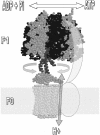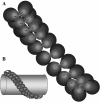Regulation of the F1F0-ATP synthase rotary nanomotor in its monomeric-bacterial and dimeric-mitochondrial forms
- PMID: 19669503
- PMCID: PMC2577739
- DOI: 10.1007/s10867-008-9114-z
Regulation of the F1F0-ATP synthase rotary nanomotor in its monomeric-bacterial and dimeric-mitochondrial forms
Abstract
The F(1)F(0)-adenosine triphosphate (ATP) synthase rotational motor synthesizes most of the ATP required for living from adenosine diphosphate, Pi, and a proton electrochemical gradient across energy-transducing membranes of bacteria, chloroplasts, and mitochondria. However, as a reversible nanomotor, it also hydrolyzes ATP during de-energized conditions in all energy-transducing systems. Thus, different subunits and mechanisms have emerged in nature to control the intrinsic rotation of the enzyme to favor the ATP synthase activity over its opposite and commonly wasteful ATPase turnover. Recent advances in the structural analysis of the bacterial and mitochondrial ATP synthases are summarized to review the distribution and mechanism of the subunits that are part of the central rotor and regulate its gyration. In eubacteria, the epsilon subunit works as a ratchet to favor the rotation of the central stalk in the ATP synthase direction by extending and contracting two alpha-helixes of its C-terminal side and also by binding ATP with low affinity in thermophilic bacteria. On the other hand, in bovine heart mitochondria, the so-called inhibitor protein (IF(1)) interferes with the intrinsic rotational mechanism of the central gamma subunit and with the opening and closing of the catalytic beta-subunits to inhibit its ATPase activity. Besides its inhibitory role, the IF(1) protein also promotes the dimerization of the bovine and rat mitochondrial enzymes, albeit it is not essential for dimerization of the yeast F(1)F(0) mitochondrial complex. High-resolution electron microscopy of the dimeric enzyme in its bovine and yeast forms shows a conical shape that is compatible with the role of the ATP synthase dimer in the formation of tubular the cristae membrane of mitochondria after further oligomerization. Dimerization of the mitochondrial ATP synthase diminishes the rotational drag of the central rotor that would decrease the coupling efficiency between rotation of the central stalk and ATP synthesis taking place at the F(1) portion. In addition, F(1)F(0) dimerization and its further oligomerization also increase the stability of the enzyme to natural or experimentally induced destabilizing conditions.
Figures





Similar articles
-
Control of rotation of the F1FO-ATP synthase nanomotor by an inhibitory α-helix from unfolded ε or intrinsically disordered ζ and IF1 proteins.J Bioenerg Biomembr. 2018 Oct;50(5):403-424. doi: 10.1007/s10863-018-9773-9. Epub 2018 Sep 28. J Bioenerg Biomembr. 2018. PMID: 30267331 Review.
-
Unidirectional regulation of the F1FO-ATP synthase nanomotor by the ζ pawl-ratchet inhibitor protein of Paracoccus denitrificans and related α-proteobacteria.Biochim Biophys Acta Bioenerg. 2018 Sep;1859(9):762-774. doi: 10.1016/j.bbabio.2018.06.005. Epub 2018 Jun 8. Biochim Biophys Acta Bioenerg. 2018. PMID: 29886048 Review.
-
Large conformational changes of the epsilon subunit in the bacterial F1F0 ATP synthase provide a ratchet action to regulate this rotary motor enzyme.Proc Natl Acad Sci U S A. 2001 Jun 5;98(12):6560-4. doi: 10.1073/pnas.111128098. Epub 2001 May 29. Proc Natl Acad Sci U S A. 2001. PMID: 11381110 Free PMC article.
-
Formation of the yeast F1F0-ATP synthase dimeric complex does not require the ATPase inhibitor protein, Inh1.J Biol Chem. 2002 Oct 18;277(42):39289-95. doi: 10.1074/jbc.M205720200. Epub 2002 Aug 6. J Biol Chem. 2002. PMID: 12167646
-
Structures and interactions of proteins involved in the coupling function of the protonmotive F(o)F(1)-ATP synthase.Curr Protein Pept Sci. 2002 Aug;3(4):451-60. doi: 10.2174/1389203023380558. Curr Protein Pept Sci. 2002. PMID: 12370007 Review.
Cited by
-
The Inhibitory Mechanism of the ζ Subunit of the F1FO-ATPase Nanomotor of Paracoccus denitrificans and Related α-Proteobacteria.J Biol Chem. 2016 Jan 8;291(2):538-46. doi: 10.1074/jbc.M115.688143. Epub 2015 Nov 6. J Biol Chem. 2016. PMID: 26546676 Free PMC article.
-
Tapetum-specific expression of a cytoplasmic orf507 gene causes semi-male sterility in transgenic peppers.Front Plant Sci. 2015 Apr 22;6:272. doi: 10.3389/fpls.2015.00272. eCollection 2015. Front Plant Sci. 2015. PMID: 25954296 Free PMC article.
-
NMR structures of α-proteobacterial ATPase-regulating ζ-subunits.J Mol Biol. 2014 Jul 15;426(14):2547-53. doi: 10.1016/j.jmb.2014.05.004. Epub 2014 May 13. J Mol Biol. 2014. PMID: 24838125 Free PMC article.
-
Control of rotation of the F1FO-ATP synthase nanomotor by an inhibitory α-helix from unfolded ε or intrinsically disordered ζ and IF1 proteins.J Bioenerg Biomembr. 2018 Oct;50(5):403-424. doi: 10.1007/s10863-018-9773-9. Epub 2018 Sep 28. J Bioenerg Biomembr. 2018. PMID: 30267331 Review.
-
A high-resolution route map reveals distinct stages of chondrocyte dedifferentiation for cartilage regeneration.Bone Res. 2022 Apr 27;10(1):38. doi: 10.1038/s41413-022-00209-w. Bone Res. 2022. PMID: 35477573 Free PMC article.
References
-
- {'text': '', 'ref_index': 1, 'ids': [{'type': 'PubMed', 'value': '13734097', 'is_inner': True, 'url': 'https://pubmed.ncbi.nlm.nih.gov/13734097/'}]}
- Penefsky, H.S., Pullman, M.E., Datta, A., Racker, E.: Partial resolution of the enzymes catalyzing oxidative phosphorylation. II. Participation of a soluble adenosine triphosphatase in oxidative phosphorylation. J. Biol. Chem. 235, 3330–3336 (1960) - PubMed
-
- {'text': '', 'ref_index': 1, 'ids': [{'type': 'DOI', 'value': '10.1007/BF00831537', 'is_inner': False, 'url': 'https://doi.org/10.1007/bf00831537'}, {'type': 'PubMed', 'value': '7721724', 'is_inner': True, 'url': 'https://pubmed.ncbi.nlm.nih.gov/7721724/'}]}
- Souid, A.K., Penefsky, H.S.: Mechanism of ATP synthesis by mitochondrial ATP synthase from beef heart. J. Bioenerg. Biomembranes 26, 627–630 (1994). doi:10.1007/BF00831537 - PubMed
-
- {'text': '', 'ref_index': 1, 'ids': [{'type': 'DOI', 'value': '10.1111/j.1432-1033.1997.00622.x', 'is_inner': False, 'url': 'https://doi.org/10.1111/j.1432-1033.1997.00622.x'}, {'type': 'PubMed', 'value': '9370375', 'is_inner': True, 'url': 'https://pubmed.ncbi.nlm.nih.gov/9370375/'}]}
- García, J.J., Gómez-Puyou, A., Maldonado, E., Tuena de Gómez-Puyou, M.: Acceleration of unisite catalysis of mitochondrial F1-adenosinetriphosphatase by ATP, ADP and pyrophosphate—hydrolysis and release of the previously bound [gamma-32P]ATP. Eur. J. Biochem. 249(2), 622–229 (1997). doi:10.1111/j.1432-1033.1997.00622.x - PubMed
-
- {'text': '', 'ref_index': 1, 'ids': [{'type': 'DOI', 'value': '10.1074/jbc.273.26.15940', 'is_inner': False, 'url': 'https://doi.org/10.1074/jbc.273.26.15940'}, {'type': 'PubMed', 'value': '9632641', 'is_inner': True, 'url': 'https://pubmed.ncbi.nlm.nih.gov/9632641/'}]}
- García, J.J., Capaldi, R.A.: Unisite catalysis without rotation of the gamma-epsilon domain in Escherichia coli F1-ATPase. J. Biol. Chem. 273(26), 15940–15945 (1998). doi:10.1074/jbc.273.26.15940 - PubMed
-
- None
- García, J.J.: The F0F1-ATP synthase: binding energy, coupling and rotational catalysis. In: Pandalai, S.G. (ed.) Recent Research Developments in Bioenergetics, p. 41. Transworld Research Network, Trivandrum (2000)
LinkOut - more resources
Full Text Sources
Molecular Biology Databases
Research Materials
Miscellaneous

